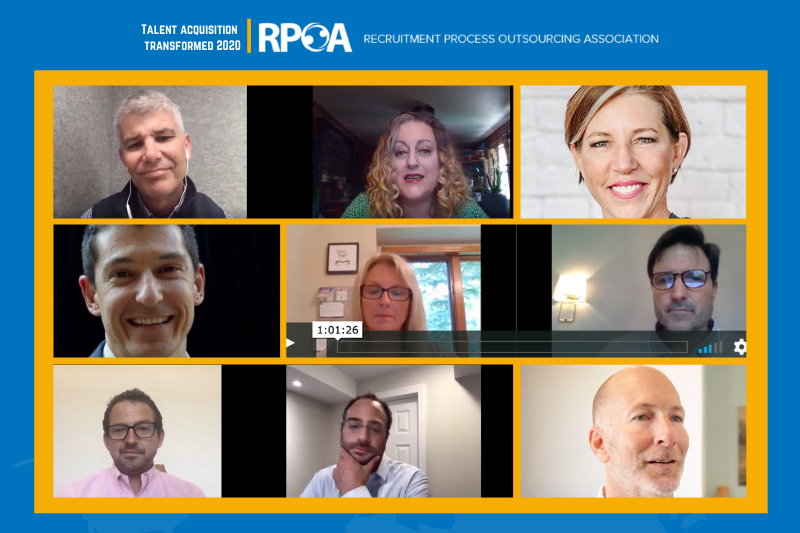
The 2nd annual RPOA virtual conference entitled Recharge, Refocus, and Revitalize was held on October 12, 2021. Zach Chertok, Columbia University Associate Professor and Research Manager with IDC, kicked off the conference with a powerful and informative keynote address titled The New Old War for Top Talent.
In his address, Chertok pointed out that the factors that created the war for top talent before the pandemic haven’t changed post-pandemic or after "one year in" to the pandemic. He noted that the talent bottlenecks that existed in 2019 exist today. And the causes for those bottlenecks remain the same. He explained how Recruitment Process Outsourcing (RPO) uses its strategic mindset to attract and retain the talent organizations need. This post highlights the key takeaways from Chertok's address.
Pre-Pandemic
Before the pandemic, Chertok said, "the war for top talent was white-hot as we were looking at new ways and strategies to approach hiring that would find the 100% best-fit, most perfect candidate who was a culture match, had the fastest learning curve on the market today, and who would be ready to get to work out of onboarding in less than a month."
Chertok noted that between 2017 and 2020, talent organizations lived in a world where the search for "unicorn candidates" preoccupied the strategies of most talent acquisition (TA) leaders. He said that this narrow focus on getting the perfect candidate created a world of high expectations. And these high expectations resulted in:
- Ignorance of the internal conditions of the organization
- Misalignment of sourcing skills with talent
- Blindness to the resources needed to help talent meet the company’s expectations, and
- Widening of the gap between the make-up of the workforce at that time and the one yet to come.
Before the pandemic, all the signs indicated that the talent market should have been an employers' market. But Chertok observed that organizations' misunderstanding of the availability and readiness of talent wiped out any chance for an employer-led market.
The Elephant in the Room
Chertok also explained that companies were always on the brink of losing their aging baby boomers before the pandemic. But catastrophe after catastrophe forced baby boomers to keep working. And companies failed to address the elephant in the room. Chertok ran a survey at the start of the pandemic to measure companies’ preparedness regarding baby boomers leaving the workforce. His research found that more than three-quarters of the organizations surveyed hadn’t prepared for baby boomers exiting the workforce.
Chertok highlighted that from the tech bubble burst, 9/11, to the recession of 2008, baby boomers had to keep working. And organizations never stopped to consider the big day of a generational shift in the workforce.
The Catastrophe That Broke the Camel's Back
With each crisis, baby boomers kept working. The boomers helped out companies with continuing to work. And organizations kept putting off any plans to solve the baby boomers' impending exit from the labor force.
But then came covid-19. Chertok posed the following question, "What happens when a lack of industry preparation for a generational shift and an industry-built lack of generational skills transfer meets a global health crisis?"
"We have upheaval," Chertok answered. Covid-19 has forced companies to deal with the generational shift in their workforce whether they're ready for it or not. Chertok pointed out that industry experts knew they would have to deal with baby boomers leaving the workforce within the next two to five years. But because of the pandemic, they have to deal with it now.
The result of this disruption, Chertok noticed, is that baby boomers are leaving the workforce faster than anticipated. And their exit has created a flood of candidates in the talent market.
The New Old War for Top Talent Continues
Chertok noted that the war for top talent continues as we move into the "one year in" of the pandemic. He said that there are some different problems companies need to deal with, primarily baby boomers leaving the workforce faster than expected.
But he explained that many of the same problems that existed during the war for talent pre-pandemic still exist post-pandemic. He said that those similarities include:
- High Expectations
- Technology programmed to match role-based needs
- Lack of business diversity
Chertok observed that companies still have high expectations in role-based hiring--companies continue to look for one hire per role. He noted that skills-based hiring is as much a distant dream in 2021 as it was in 2019. He said companies are not hiring based on skills "because [this approach] has not been well-aligned with the framing of the business plan that defines HR objectives, at least not across all industries and employers." Chertok added that skills in demand are highly specialized because of business plans focused on incremental innovation instead of industry expansion.
Because companies continue to focus on role-based hiring, Chertok said that companies still program their recruitment technology to match role-based needs. From Chertok's point of view, this approach ignores high skills quotients, learning curves, and supplemental abilities, all of which companies need to focus on for a post-baby boomer workforce.
Chertok also said that the lack of business diversity is the same as pre-pandemic. He observed that job growth remains stilted because of specialization. And skill specializations have created consolidation of industries; in turn, it has erased the mid-market as a source for independent talent. He said that there's a direct relationship between the lack of business diversity and the absence of diverse strategies to source hiring success.
The Role of RPO
Chertok pointed out to the audience that RPOs (recruitment process outsourcing providers) play a huge role in the current war for top talent. He reminded all of the RPOs present of the value their strategic partnership approach brings to a client's hiring situation. He recommended five ways RPOs can enhance their strategic value.
First, don't let technology replace the human touch in the hiring process. Technology allows individual recruiters to handle more requisitions at any time, providing them agility.
Second, help your clients to use technology more innovatively. Using technology smarter, Chertok said, means that RPOs and their clients can use technology "based on what the market is telling both [the RPO and its client] inside and outside the organization."
Third, Chertok said that RPOs should use good and bad results for "improving the process, amending the strategy, and building the partnerships that will always facilitate a talent supply even if that supply comes from changing sources."
Fourth, he said, "[RPOs] best hedge against failure is to fail often and keep improving." And failing often means RPOs embracing change. He reminded the audience that it's good to accept change. He added that if RPOs can't accept change, their clients won't accept change either.
Fifth, Chertok’s last suggestion was don't ignore the 70 percent candidate. He said that 70-percent candidates grow and apply themselves that exceed expectations. He added that these candidates are not people pleasers. They excel to please their inner selves, not their boss.
We hope this recap has whet your appetite to watch the Recharge, Refocus, Revitalize Conference. If you want to get fully energized for 2022, we invite you to watch the RPOA Conference 2021 on demand.














